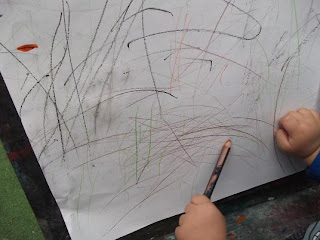Wednesday 20th April 2011
The babies love to experiment with different drawing utensils on paper. They have used felt pens, pencils, ball point pens, crayons and pastels. Their most common and favourite scribbling tool is the coloured pencils. While the children have explored many different writing and drawing equipment they have not explored different surfaces to draw on. Whenever the children do art it is always on some kind of paper or card. I wanted to provide a different surface to draw on so when our centre got brand new individual chalkboards I thought what a great opportunity for them. Chalkboards or blackboards are an old technology. I remember watching them get phased out at primary school by whiteboards. They are often not seen at school anymore and not many children would have ever come across them.
I set the Chalkboards on the table inside with some dusters and jumbo chalk. It wasn’t long before the children notice the new chalkboards and came over to the table to investigate. The children immediately knew what to do with the chalk and began scribbling on the chalkboards. I noticed that the dusters were being neglected so joined in at the table and modelled to the children how the dusters were used. This brought a whole new behaviour to the activity. Before the children were drawing large scribble patterns on the chalkboards but now that they understood the use of the duster they were drawing smaller scribbles then immediately erasing them with the duster. The children repeated this action of scribbling and erasing over and over.
This activity through the use of chalkboards was very interesting for the children. It was new and exciting and offered an alternative to drawing on paper. The children learnt a lot through their drawing and scribbling too. Somerset (2000) recognises the special value of drawing by stating “Drawing is a necessary activity for children, filling needs not provided for in painting” (p. 28). She goes on to say that the ability to hold a pencil, which is needed later in life, starts with experimenting through scribbling. Drawing develops the muscles in the hand (fine motor skills) which is an exercise that children find satisfying. Wright (2008) also recognises that drawing is empowering for children. She talks about how through drawing, children discover that they have the power to make marks. For two year olds drawing is an extension of their hand and arm movements as they gradually learn to control and shape the marks that occur.
This has been the babies’ first experience drawing with chalk on chalkboards and will certainly not be their last. The children have had so much fun and have developed so much learning through the use of this old technology. I will defiantly continue to provide this activity for the children in my room and not get stuck in the rut that drawing only happens on paper.
Somerset, G,. (2000). Work and play in the early years. New Zealand: New Zealand Play centre Federation.
Wright, S,. (2003). The Arts, Young Children, and Learning. Boston: Pearson Education Inc.




Chalkboards, I haven’t seen or used chalkboards with the children for a long, long time now. It is fantastic to see that some of the older technology’s are staying alive. It is a great reminder of how the children can still gain knowledge and skills from old school equipment.
ReplyDeleteWhat a great job you have done continuing the children’s learning and development through their interest in drawing. I see that you were facilitating the children’s learning by providing the appropriate materials and resources – chalk and chalkboards. MacNaughton and Williams (2009) discuss that “facilitating refers to the process of making children’s learning easier” (p81). Your teaching technique of demonstrating, when you showed them the purpose of the duster and how to use it, allowed the children to gain the knowledge in a new experience and continue forward in the learning process of this experience. The drawing did give the children plenty of opportunity for extending their fine motor control and skills. Another technology tool for fine motor development I have been introducing to the children at meal times is ‘tongs.’ Using the tongs (small child sized ones) at meal times helps the younger children to practice the pincher grasp used for holding a pencil. I have also seen tongs used in manipulative activities such as sorting and grouping objects of varied sizes. This also exposes the children to mathematical learning.
I can’t wait to hear about the children’s next experience with the chalkboards, we all know how important repetition is for infants and toddlers learning.
Thanks for your input Tina. Its great to hear back and get feedback on my reflective blog entries. I love your idea about the tongs. I saw some miniture tongs in our kitchen and decided to get the children to use them at morning tea. It took them awhile to get the hang of it but they had so much fun expreimenting with them. Thanks again for the great idea.
ReplyDelete